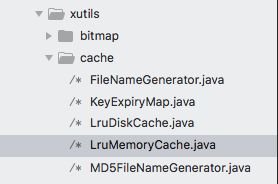本文使是以xUtils 2.6的版本来解析源码,可分为以下几个部分:
- cache 缓存
- view 注解
- db 数据库
- http 网络
1. cache
首先来看看FileNameGenerator这个接口,其中有一个方法generate方法,生成文件名称,MD5FileNameGenerator实现了该方法,并且采用MD5算法。
public String generate(String key) {
String cacheKey;
try {
final MessageDigest mDigest = MessageDigest.getInstance("MD5");
mDigest.update(key.getBytes());
cacheKey = bytesToHexString(mDigest.digest());
} catch (NoSuchAlgorithmException e) {
cacheKey = String.valueOf(key.hashCode());
}
return cacheKey;
}
private String bytesToHexString(byte[] bytes) {
StringBuilder sb = new StringBuilder();
for (int i = 0; i < bytes.length; i++) {
String hex = Integer.toHexString(0xFF & bytes[i]);
if (hex.length() == 1) {
sb.append('0');
}
sb.append(hex);
}
return sb.toString();
}
KeyExpiryMap继承自ConcurrentHashMap,存储类型为范型
@Override
public synchronized Long put(K key, Long expiryTimestamp) {
if (this.containsKey(key)) {
this.remove(key);
}
return super.put(key, expiryTimestamp);
}
@Override
public synchronized boolean containsKey(Object key) {
boolean result = false;
Long expiryTimestamp = super.get(key);
if (expiryTimestamp != null && System.currentTimeMillis() < expiryTimestamp) {
result = true;
} else {
this.remove(key);
}
return result;
}
LruMemoryCache 为实现了最近最少使用算法,可参考这边博客Java 最近最少使用算法(LRU)。其内部保存了一个LinkedHashMap、KeyExpiryMap对象的应用。
public final V get(K key) {
if (key == null) {
throw new NullPointerException("key == null");
}
V mapValue;
synchronized (this) {
// If expired, remove the entry.
if (!keyExpiryMap.containsKey(key)) {
this.remove(key);
return null;
}
mapValue = map.get(key);
if (mapValue != null) {
hitCount++;
return mapValue;
}
missCount++;
}
/*
* Attempt to create a value. This may take a long time, and the map
* may be different when create() returns. If a conflicting value was
* added to the map while create() was working, we leave that value in
* the map and release the created value.
*/
V createdValue = create(key);
if (createdValue == null) {
return null;
}
synchronized (this) {
createCount++;
mapValue = map.put(key, createdValue);
if (mapValue != null) {
// There was a conflict so undo that last put
map.put(key, mapValue);
} else {
size += safeSizeOf(key, createdValue);
}
}
if (mapValue != null) {
entryRemoved(false, key, createdValue, mapValue);
return mapValue;
} else {
trimToSize(maxSize);
return createdValue;
}
}
public final V put(K key, V value) {
return put(key, value, Long.MAX_VALUE);
}
public final V put(K key, V value, long expiryTimestamp) {
if (key == null || value == null) {
throw new NullPointerException("key == null || value == null");
}
V previous;
synchronized (this) {
putCount++;
size += safeSizeOf(key, value);
previous = map.put(key, value);
keyExpiryMap.put(key, expiryTimestamp);
if (previous != null) {
size -= safeSizeOf(key, previous);
}
}
if (previous != null) {
entryRemoved(false, key, previous, value);
}
trimToSize(maxSize);
return previous;
}
private void trimToSize(int maxSize) {
while (true) {
K key;
V value;
synchronized (this) {
if (size <= maxSize || map.isEmpty()) {
break;
}
Map.Entry toEvict = map.entrySet().iterator().next();
key = toEvict.getKey();
value = toEvict.getValue();
map.remove(key);
keyExpiryMap.remove(key);
size -= safeSizeOf(key, value);
evictionCount++;
}
entryRemoved(true, key, value, null);
}
}
public final V remove(K key) {
if (key == null) {
throw new NullPointerException("key == null");
}
V previous;
synchronized (this) {
previous = map.remove(key);
keyExpiryMap.remove(key);
if (previous != null) {
size -= safeSizeOf(key, previous);
}
}
if (previous != null) {
entryRemoved(false, key, previous, null);
}
return previous;
}
2. view
ContentView 、ViewInject、OnClick注解
@Target(ElementType.TYPE)
@Retention(RetentionPolicy.RUNTIME)
public @interface ContentView {
int value();
}
@Target(ElementType.FIELD)
@Retention(RetentionPolicy.RUNTIME)
public @interface ViewInject {
int value();
/* parent view id */
int parentId() default 0;
}
@Target(ElementType.METHOD)
@Retention(RetentionPolicy.RUNTIME)
@EventBase(
listenerType = View.OnClickListener.class,
listenerSetter = "setOnClickListener",
methodName = "onClick")
public @interface OnClick {
int[] value();
int[] parentId() default 0;
}
最主要的类就是ViewUtils。
public static void inject(Activity activity) {
injectObject(activity, new ViewFinder(activity));
}
@SuppressWarnings("ConstantConditions")
private static void injectObject(Object handler, ViewFinder finder) {
Class handlerType = handler.getClass();
// inject ContentView
ContentView contentView = handlerType.getAnnotation(ContentView.class);
if (contentView != null) {
try {
Method setContentViewMethod = handlerType.getMethod("setContentView", int.class);
setContentViewMethod.invoke(handler, contentView.value());
} catch (Throwable e) {
LogUtils.e(e.getMessage(), e);
}
}
// inject view
Field[] fields = handlerType.getDeclaredFields();
if (fields != null && fields.length > 0) {
for (Field field : fields) {
ViewInject viewInject = field.getAnnotation(ViewInject.class);
if (viewInject != null) {
try {
View view = finder.findViewById(viewInject.value(), viewInject.parentId());
if (view != null) {
field.setAccessible(true);
field.set(handler, view);
}
} catch (Throwable e) {
LogUtils.e(e.getMessage(), e);
}
} else {
ResInject resInject = field.getAnnotation(ResInject.class);
if (resInject != null) {
try {
Object res = ResLoader.loadRes(
resInject.type(), finder.getContext(), resInject.id());
if (res != null) {
field.setAccessible(true);
field.set(handler, res);
}
} catch (Throwable e) {
LogUtils.e(e.getMessage(), e);
}
} else {
PreferenceInject preferenceInject = field.getAnnotation(PreferenceInject.class);
if (preferenceInject != null) {
try {
Preference preference = finder.findPreference(preferenceInject.value());
if (preference != null) {
field.setAccessible(true);
field.set(handler, preference);
}
} catch (Throwable e) {
LogUtils.e(e.getMessage(), e);
}
}
}
}
}
}
// inject event
Method[] methods = handlerType.getDeclaredMethods();
if (methods != null && methods.length > 0) {
for (Method method : methods) {
Annotation[] annotations = method.getDeclaredAnnotations();
if (annotations != null && annotations.length > 0) {
for (Annotation annotation : annotations) {
Class annType = annotation.annotationType();
if (annType.getAnnotation(EventBase.class) != null) {
method.setAccessible(true);
try {
// ProGuard:-keep class * extends java.lang.annotation.Annotation { *; }
Method valueMethod = annType.getDeclaredMethod("value");
Method parentIdMethod = null;
try {
parentIdMethod = annType.getDeclaredMethod("parentId");
} catch (Throwable e) {
}
Object values = valueMethod.invoke(annotation);
Object parentIds = parentIdMethod == null ? null : parentIdMethod.invoke(annotation);
int parentIdsLen = parentIds == null ? 0 : Array.getLength(parentIds);
int len = Array.getLength(values);
for (int i = 0; i < len; i++) {
ViewInjectInfo info = new ViewInjectInfo();
info.value = Array.get(values, i);
info.parentId = parentIdsLen > i ? (Integer) Array.get(parentIds, i) : 0;
EventListenerManager.addEventMethod(finder, info, annotation, handler, method);
}
} catch (Throwable e) {
LogUtils.e(e.getMessage(), e);
}
}
}
}
}
}
}

